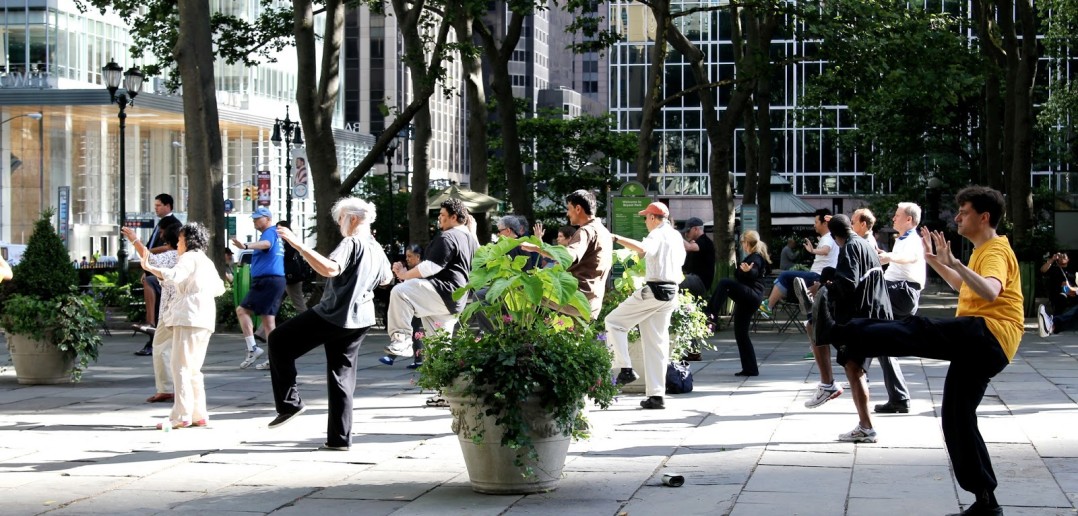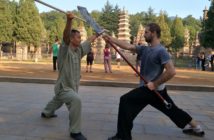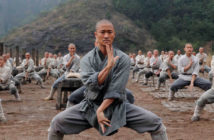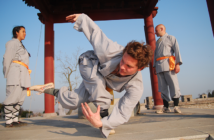Last month I had the pleasure of interviewing Marc Meyer a writer, martial artists and musician about his latest book Taichi: The Story of a Chinese Master in America.
Marc’s novel tells the story of a man who leaves China in the early 1960’s to open a T’ai Chi school and reconnect with his Asian American family in Chinatown, New York City. The main character in the story was once the bodyguard of Mme Chiang Kai Shek. It’s bright red cover below spells out the words T’ai Chi Chuan in Chinese pictograms. And the novel is a must read for lovers of tai chi and Asian American fiction alike.
It was inspired by the legendary T’ai Chi grandmaster Cheng Man-Ching and his American students during the period of the 1960’s in New York City. It tells of a time, years before the advent of Bruce Lee movies, when the Kung Fu art of T’ai Chi Chuan was first introduced into the United States and was secretly practiced only in small enclaves of America’s Chinatowns.
The book
Marc can you tell me little about your book? And some of the Characters in it?
Allow me to reiterate my book is a work of fiction. As you are possibly aware, authenticity when it comes to T’ai Chi Chuan in and of itself is a murky business, due mainly to the fact that much of the teaching we have was passed down to us orally by it’s forebears. Very little about it was actually written down. Many of the forebears of T’ai Chi chuan were illiterate and its origins go back several thousand years. This makes the art form somewhat mysterious which is actually what I like about it.
I’ve found Douglas Wyle’s books to be one of the more reliable sources of reference when it comes to the origins and practice of T’ai Chi Chuan, specifically Yang style which I practice and one that I draw upon recurrently in my book. Specifically on the subject of Yang style T’ai Chi which I’ve been practing and studying for the past 18 yrs. Let me stress that study and practice of T’ai Chi should occur simultaneously and continuously for the dedicated teacher.
Taichi: The Story of a Chinese Master in America
In the book, a T’ai Chi master named Kuo Yun San leaves mainland China in the 1960’s for what he thinks is the last time. His goals are simple, he envisions opening a successful T’ai Chi school and strengthening the bonds between himself and his Asian American family in Chinatown with whom he has had little to no communication in years. The results are surprising as Master Kuo finds himself trading one Cultural Revolution for another and his newfound friends and family members, thinking they were going to educate him into adopting an American lifestyle, find he has more to teach them.
From some of the details in your book its obvious you have a solid martial arts background. Can you tell me about your own martial arts experience?
I came to T’ai Chi Chuan through the back door in a sense. A dining club my girlfriend and I belonged to offered lessons in T’ai Chi on the beach where I live in Naples Florida as one of the perks of its membership. Fortunately for me, though I didn’t know it then, both instructors who taught this class had been students of Bob Amaker, a resident of Florida who co-authored books with Cheng Man-Ching. Cheng Man-Ching was one of the main proponents of Yang style T’ai Chi Chuan in this country.
I subsequently went on to receive what’s known as form correction from Lawrence Galante, a student himself of four T’ai Chi Chuan grandmasters, Paul Guo, Yu Chen Hsiang, TsunTsai Liang and Chen Man-Ching. I received final instruction from a first generation student of Professor Cheng as he was called, from Maggie Newman, one of his last living pupils in 2006, then in her mid eighties.
Inspiration
In your book you discuss the student teacher relationship. Can you tell us a bit more about where that inspiration came from?
It’s my firm belief that every teacher involved with T’ai Chi has something to contribute to the student’s education, although many times the approaches can be radically different and often make a student doubtful about the quality of instruction that he or she is receiving. If you are getting instruction from someone in Taichi you’re unsure about, my advice is to be patient and hang in there. Looking back you may find what they had to teach gave you useful insight even if you didn’t think so at the time.
For example one of my teachers had a very holistic and somewhat esoteric approach but I learned much from him about some of the more mystical aspects of T’ai Chi I might not otherwise have been privvy to. Another was very “nuts and bolts” about his approach but taught me the kind of accuracy that is absolutely essential for the study and practice of the art.
I actually recommend that if you intend to take up T’ai Chi as a practice, that you go out of your way to learn from different teachers because you can often come away with a rounder and more beneficial education from doing so. Remember if you take up the practice of T’ai Chi you’re in it for the long haul. It can take up to a year to learn just one single form properly and up to ten years to learn it as an applicable martial art. “It’s all about the journey” sounds cliched but in the case of T’ai Chi it’s absolutely true and ongoing. You’re constantly perfecting and polishing that stone every day week, month and year of your life, which for me has turned out to be a blessing and one of it’s most cherished aspects.

Mark signing copies of his book
Martial Arts Milestones
The book mentions a number of important martial arts milestones. Can you share a few of the most important ones?
Another one of the more interesting perspectives of this fascinating, mystical and multi-faceted art is its tendency to tailor itself individually to the practitioner. For me it has offered something of use from a health standpoint at almost every age related juncture of my life since i began practicing it in my early forties. In my forties I struggled with the onset of tinnitus, a horrible and constant high pitched ringing in the ears. T’ai Chi helped to calm me down, calm my anxious feelings about it and sleep better. After I found I could sleep more easily, the problem didn’t seem to bother me so much during the day and has finally faded into the background to the point where I don’t even notice it anymore.
Another more serious problem developed when I turned sixty called Neuropathy. Another constant painful nerve related chronic disease which had equilibrium problems as one of it’s symptoms. It has taken a full year but thanks in part to Taichi I have been able to manage my symptoms and get them under control. When the doctor later asked me if if I wanted to take a class in learning how to keep my balance to prevent myself from falling I was happy to tell her “I TEACH balance!”.T’ai Chi Chuan is literally the gift that keeps on giving.
What’s next?
Finally, what’s next for Marc Meyer? Do you have other books in the pipeline?

You can find Marc’s book here by clicking the amazon link to the left. Any purchase you make via the affiliate link we will put back into www.StudyMartialArts.Org in order to help more students connect with genuine Master of Martial Arts.
Book Review by Matthew Polly
A surprisingly charming novel about a young man coming of age in Chinatown under the tutelage of his Uncle Kuo, a Taichi master. The details are so precise that there were several times I had to double-check that this was a novel and not a memoir.
Clearly the author has spent a long time learning the details of life inside a Chinese dojo, because he gets all the little things just right. I don't read many novels anymore, but this one caught hold of me and wouldn't let go until the end.
The combination of a martial arts tale infused with immigrant optimism was a buzzy delight.
-
Readability7
-
Content6
-
Accessibility8
-
Enjoyability7




